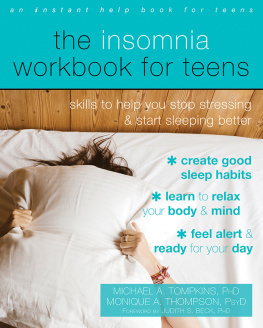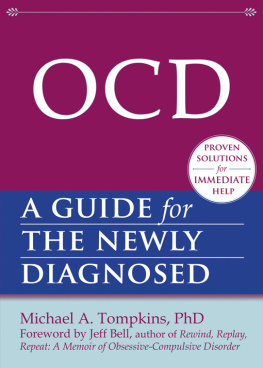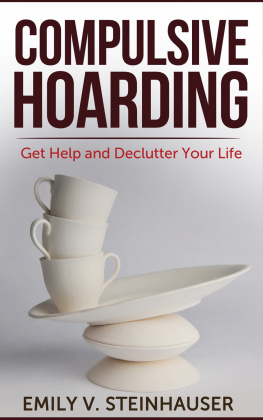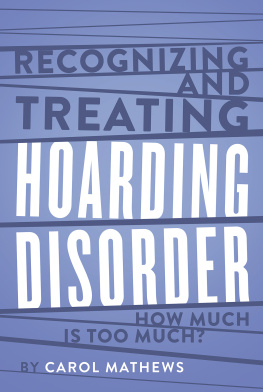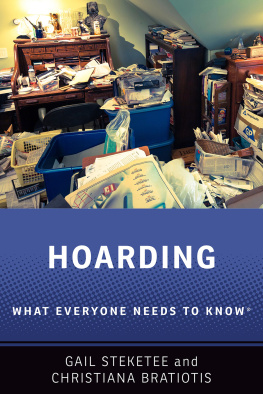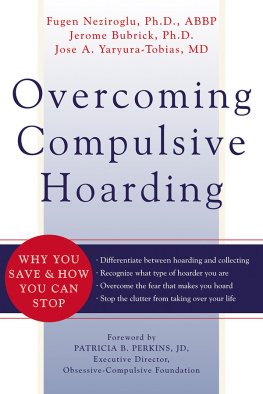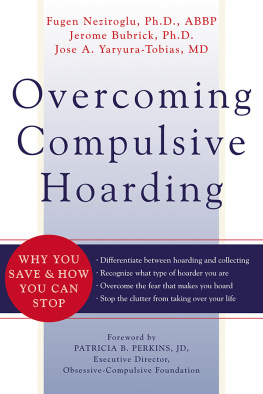If your loved one has a problem with compulsive saving, this book can help you both save what really countsyourselves! With equal parts compassion, wisdom, and practicality, Michael Tompkins and Tamara Hartl offer step-by-step instructions for helping family members and friends with hoarding challenges. The authors passion for their work comes through on every page, and their extensive experience is evident in every nugget of advice they offer.
Jeff Bell, author of When in Doubt, Make Belief: An OCD-Inspired Approach to Living with Uncertainty
An essential guide for loved ones of those who compulsively hoard. Digging Out takes a compassionate approach to both the hoarder and the family members perspective and offers practical tools that really work to reduce harm associated with clutter and improve family relationships.
Belinda Lyons, executive director of the Mental Health Association of San Francisco
Digging Out is a remarkable book. Michael Tompkins and Tamara Hartl walk the reader step-by-step through the difficult process of letting go of unrealistic expectations, healing old wounds, and helping loved ones get much-needed help for compulsive hoarding. This book is likely to become a must-read for family members of people with significant hoarding problems.
David F. Tolin, Ph.D., ABPP, director of the anxiety disorders center at The Institute of Living and adjunct associate professor of psychiatry at Yale University School of Medicine
This excellent book is a boon to people that hoard, their families, and mental health professionals. It provides a clear method, harm reduction, that has been proven effective in reducing the dangerous consequences of hoarding, yet also promotes positive relationships between the hoarder and his or her loved ones. The authors are to be commended for the benefits offered by Digging Out to the many people who have to cope with this disabling disorder.
Paul R. Munford, Ph.D., clinical psychologist and director of the Cognitive Behavioral Therapy Center for OCD and Anxiety in San Rafael, CA
Digging Out is a wonderful book for those who have family members or other loved ones with compulsive hoarding and cluttering problems. It provides a practical, realistic, in-depth, and empathic approach to helping manage this serious and often debilitating problem using harm-reduction techniques. This book manages that most difficult of combinationsproviding hope and guidance without minimizing potential obstacles to success.
Carol A. Mathews, MD, associate professor of psychiatry at the University of California, San Francisco School of Medicine
Undoubtedly, Digging Out is one of the best available texts for assisting the families of those suffering from hoarding and cluttering to declutter and help their loved ones live in a healthy environment. I highly recommend the book for all who work with or may come across people struggling with hoarding and cluttering.
Johnson Ojo, REHS, special programs manager, San Francisco Department of Public Health

Publishers Note
This publication is designed to provide accurate and authoritative information in regard to the subject matter covered. It is sold with the understanding that the publisher is not engaged in rendering psychological, financial, legal, or other professional services. If expert assistance or counseling is needed, the services of a competent professional should be sought.
Distributed in Canada by Raincoast Books
Copyright 2009 by Michael A. Tompkins & Tamara L. Hartl
New Harbinger Publications, Inc.
5674 Shattuck Avenue
Oakland, CA 94609
www.newharbinger.com
All Rights Reserved
Acquired by Tesilya Hanauer; Cover design by Amy Shoup; Edited by Nelda Street; Text design by Tracy Marie Carlson
epub ISBN: 9781608825424
Library of Congress Cataloging-in-Publication Data for the print version is on file with the publisher
To Luann, Madeleine, and Olivia, who make the trip worthwhile.
Michael A. Tompkins
To the memory of my grandfather, Linwood Wotton, whose wisdom continues to influence which challenges I choose to accept.
Tamara L. Hartl
For Those Who Are Open to Help: Treatments That Work Why They Refuse Help Digging Out How to Use This Book
Defining Compulsive Hoarding Why Save That Why People Keep Hoarding How Do You Know if Your Loved One Has the Problem Could It Be Something Else
What Is Harm Reduction Applying Harm Reduction to Compulsive Hoarding Why Harm Reduction Can Help
Let Go Understand Forgive Grab Hold
Engaging Your Loved One in the Harm Reduction Approach Introducing Your Loved One to the Harm Reduction Approach
Conducting the Home Assessment Acquisition Pathways Identifying Harm Reduction Targets
Features of a Harm Reduction Plan Putting the Harm Reduction Team Together Creating the Harm Reduction Plan Formalizing the Harm Reduction Contract
Step Carefully: Seven Steps to Successful Home Visits Why Do You Have This Here L.E.A.R.N.: Listen, Empathize, Affirm, Redirect, and Negotiate Skills for the Long Term
Six Common Reasons for Contract Failures Working Through Contract Failures Avoiding Contract Burnout Using Appropriate Pressure Making the Best of a Public Situation
When People Who Hoard Live Together When People Who Hoard Live in Assisted-Care Facilities When the Person Who Hoards Is an Older Adult How Frailty Influences Harm Reduction
There Are No Bad Guys, Only Potential Team Members Adult and Child Protective Services Health and Safety Codes Guardianship or conservatorship Eviction Notices Clear-Out Interventions
Recommended Reading Professionals Who Can Help Support Groups Other Resources Tips for Managing Paper, Mail, and E-mail Where to Donate or Recycle
Foreword
Until a few short years ago, hoarding was virtually unknown to the mental health community. Even now, many mental health treatment providers do not know how to treat hoarding, although it is quite likely that some of their clients have had hoarding problems that they did not divulge. In contrast, hoarding has been all too real to family members of people who struggle with their possessions. Every year we receive hundreds of pleas from desperate and frustrated family members who are worried about the health and safety of their hoarding loved ones. Their fears are well founded. Hoarding is a serious condition that threatens the health, the safety, and even the lives of people who suffer from it. Home conditions of someone with a serious hoarding problem can also threaten the health and safety of family members and neighbors, not to mention others, such as firefighters, who must enter and exit such dwellings in an emergency. Hoarding also carries the risk of eviction.
Hoarding has an enormous impact on relationships as well. Many people who hoard have great difficulty establishing and maintaining a marriage. They are less likely to marry and more likely to divorce (Kim, Steketee, and Frost 2001). The primary culprit in these undeveloped and fractured relationships is the cluttered condition of the home and the fact that normal livingeating, sleeping, bathing, and socializingbecomes too difficult. When the excessive acquiring and clutter pushes out the partner, and the person who hoards ends up alone, the level of clutter often escalates, putting the person at even greater risk.
Family members who call us are mostly the sons and daughters of a middle-aged or older parent who has developed a serious hoarding problem. The callers are frustrated and angry, but at the same time worried about their parents future. Most have made numerous attempts to help. These efforts follow a common storyline.


